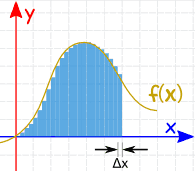Introduction to Numerical Analysis
In mathematics we usually aim for an exact answer using tools like Algebra, Geometry and Calculus.
But sometimes we can't find an answer that way, or the answer takes too long to find.
Numerical Analysis to the rescue!
Numerical Analysis gives us an approximate answer using simple calculations, and we can often use it again and again getting better answers until the error is small.

Numerical Methods
The methods are also called "algorithms" and are like recipes.
One of the famous algorithms is Newton's method.
It is very useful for finding roots (where a function crosses the axis).
We start with a guess x0, then find where that puts us on the curve.
Using that point (x0, f(x0)) and it's slope we find a new point on the axis x1 and that becomes our new guess. Repeat using x1 etc.
It does not always work (sometimes the slope sends us way away) but when it does work it is great!
Example: Newton's Method for √10
Newton's Method finds where a function equals zero (a "root").
So to find x = √10 we can use x2 − 10 = 0
The slope of x2 − 10 is 2x (using deriviatives)
After one round we have √10 ≈ 3.1666...
Our calculator says √10 = 3.16227766..., good so far.
Let's try another round:
That is really good!
Try one more round yourself and see what you get.
Other Methods
There are many clever and interesting methods. Each has strengths and weaknesses.
Another way to find roots is the Bisection Method, or "binary chop". We start either side of the root, one side with positive y, the other with negative y. We choose a value in between, calculate its value and then reduce the interval, making sure to keep one negative and one positive y value.

There are also many methods for doing integrals such as Simpson's Rule (see Integral Approximations and Integral Approximation Calculator).
Also have a play with a simple computer model of reflection inside an ellipse. The errors accumulate but it is still fun to watch, or the single pendulum or double pendulum animation (which also suffers from accumulating errors).
It is actually heaps of fun seeing answers getting better and better (or worse and worse) as the computer works through them.
More complex examples include:
- Weather prediction
- Economic Models (predicting interest rates, unemployment, etc)
- Public health vs infectious diseases
- Models of how large structures behave under stress (bridges, skyscrapers, etc)
- Many more ...
If you become an expert in any of those you will have a good and satisfying career.